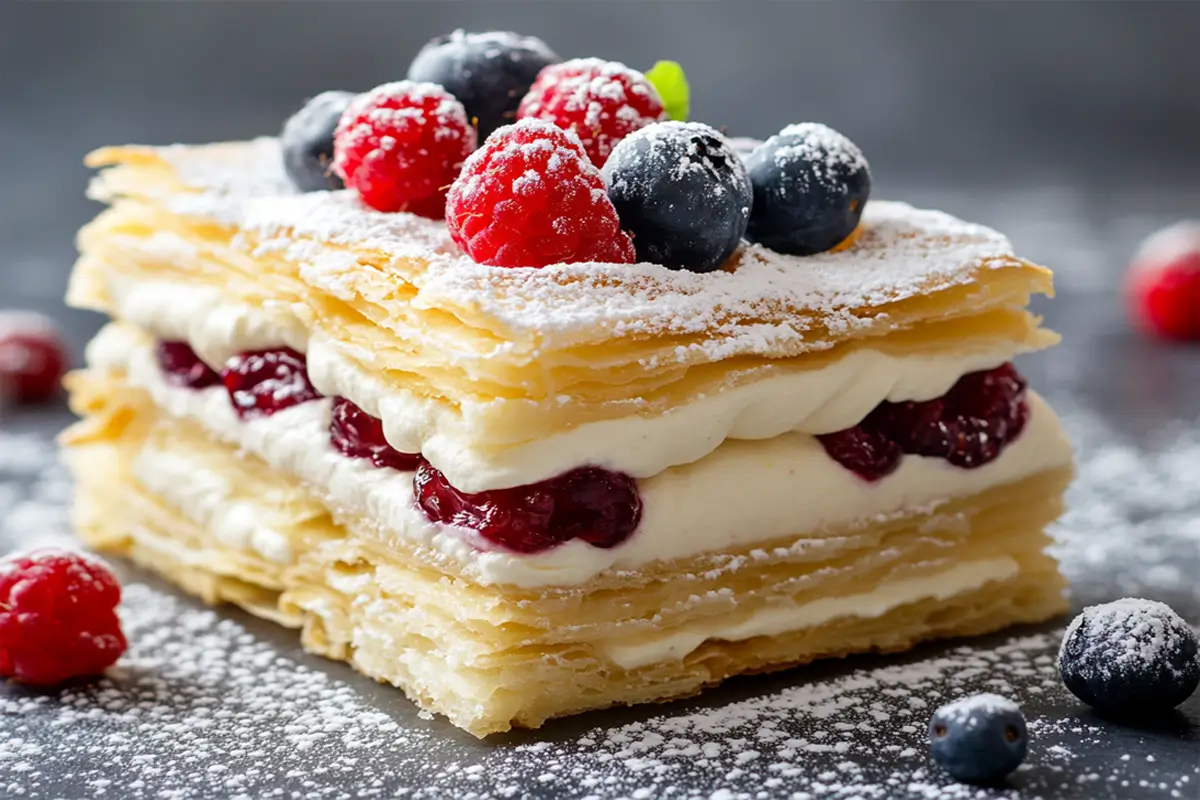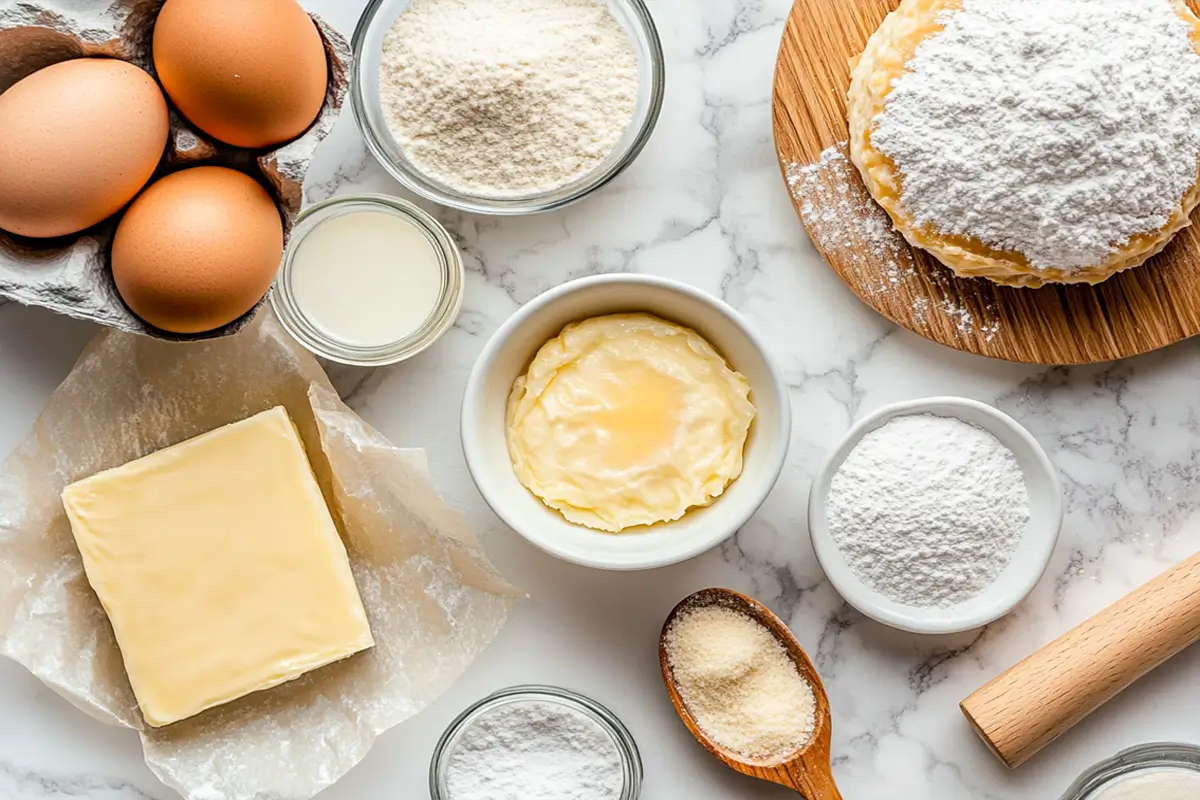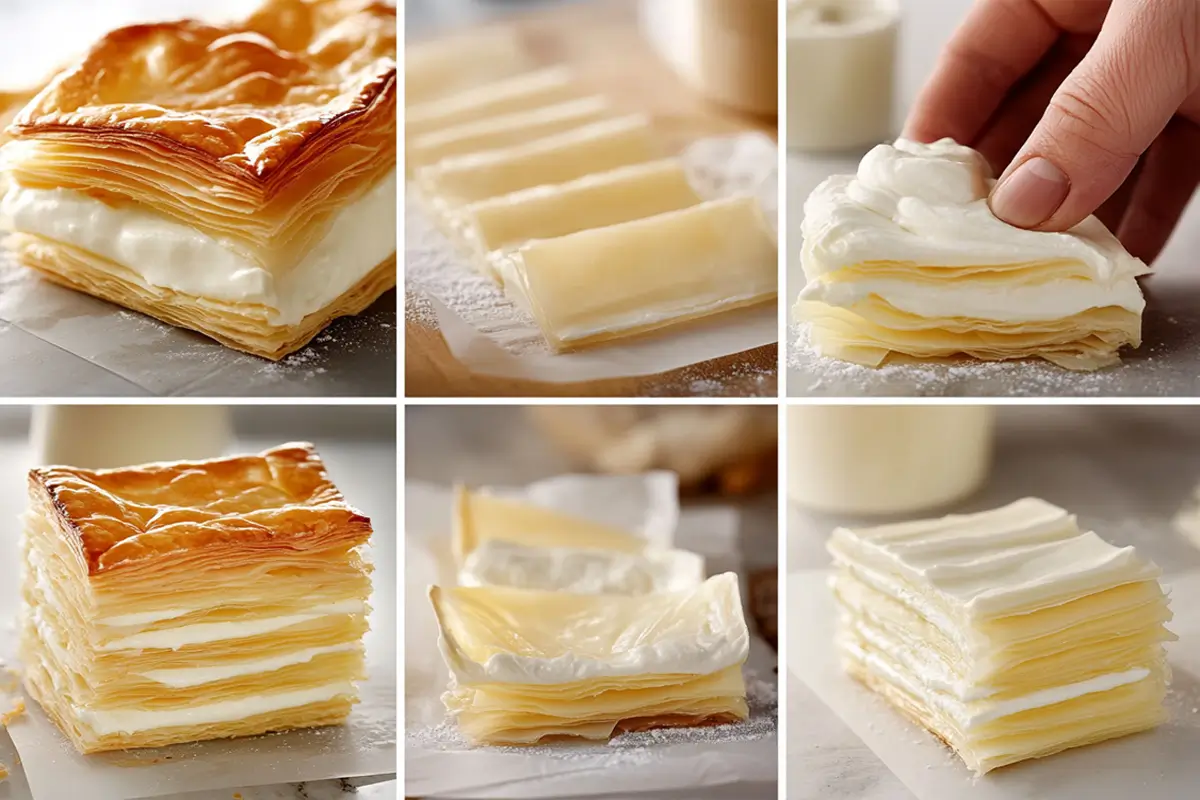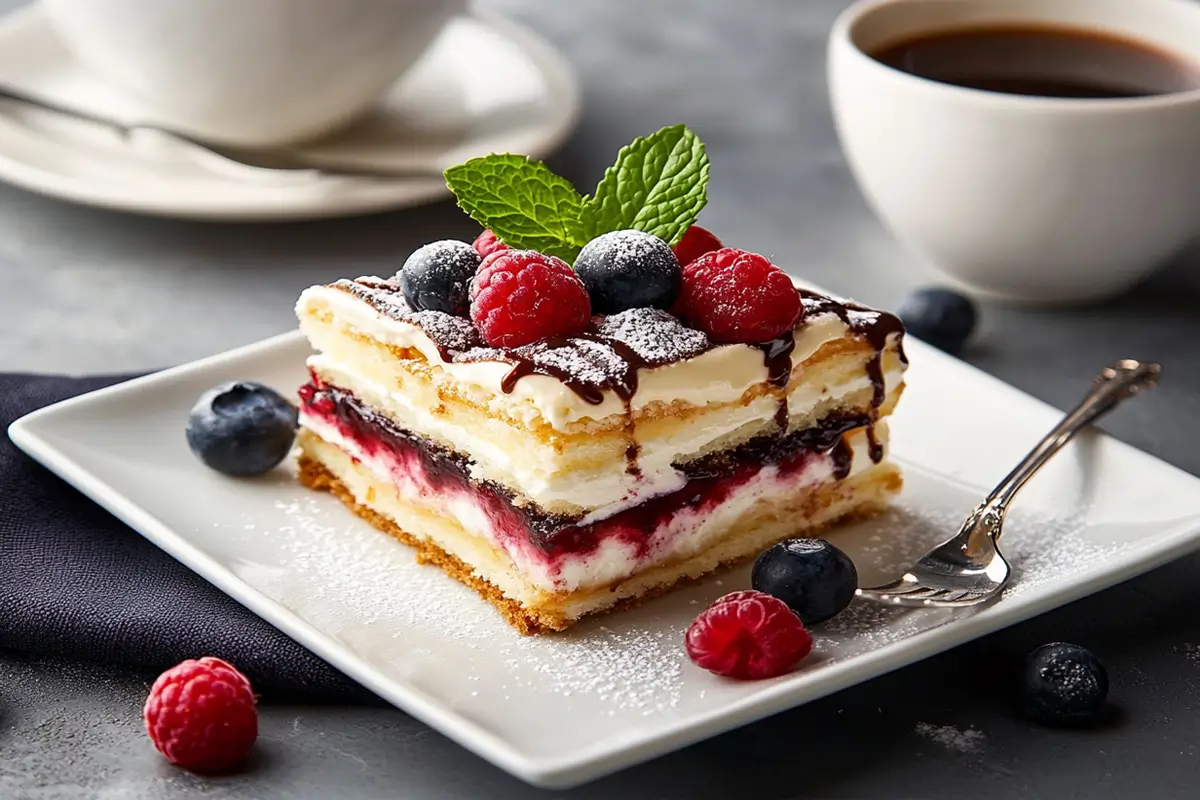The Napoleon dessert, or mille-feuille, is a pastry masterpiece with flaky puff pastry and creamy filling. Its buttery layers and smooth custard create a delightful contrast. Though its origins are unclear, its enduring popularity speaks to its appeal. This guide covers the classic Napoleon, its components, history, and tips for perfecting the balance of flakiness and creaminess.
Unlocking the Secrets of the Perfect Napoleon Dessert

What Is a Napoleon Dessert? Deconstructing the Delight
The Napoleon dessert combines two key elements:
- Puff Pastry: Flaky and crunchy layers created by folding butter into dough, which puffs up during baking.
- Pastry Cream: A rich, airy filling made from milk, sugar, eggs, and cornstarch, often flavored with vanilla or lemon.
Typically, it has three layers of puff pastry and two of pastry cream, topped with glaze or powdered sugar. The balance between cream and pastry is essential for the perfect texture.
The Key Elements: Ingredients for a Napoleon Masterpiece

Creating a classic Napoleon requires careful ingredient selection:
- Puff Pastry: Homemade offers better control for flavor and flakiness, but store-bought can save time. Choose an all-butter version for best results.
- Milk: Whole milk gives the pastry cream a rich, smooth texture.
- Sugar: Granulated sugar sweetens the cream, with the amount adjustable to taste.
- Eggs: Egg yolks thicken the cream, providing richness and smoothness.
- Cornstarch: Stabilizes the pastry cream and thickens it.
- Vanilla Extract: Pure vanilla enhances the cream’s flavor.
- Powdered Sugar: Used to dust the top for sweetness and elegance.
- Optional Glaze: A simple glaze made from powdered sugar, milk, and lemon juice adds a glossy finish.
Crafting the Napoleon: Step-by-Step Instructions for a Classic Dessert

Creating a classic Napoleon dessert requires patience and attention to detail, but the results are well worth the effort. Follow these step-by-step instructions to create your own:
Step 1: Prepare the Puff Pastry
- Thawing (If Using Store-Bought): Thaw the puff pastry according to package instructions. Ensure it’s fully thawed, but not too warm to handle easily.
- Cutting: Cut the pastry into three equal rectangles, adjusting size based on your desired Napoleon dimensions.
- Pricking: Place the rectangles on a parchment-lined baking sheet and prick all over with a fork. This step prevents uneven puffing by allowing steam to escape.
- Baking: Bake in a preheated oven at 400°F (200°C) for 15-20 minutes, or until golden brown and puffed. Keep an eye on it to avoid burning.
- Cooling: Allow the baked pastry to cool completely on a wire rack.
Step 2: Make the Pastry Cream
- Combining Ingredients: In a medium saucepan, whisk together the milk, sugar, egg yolks, and cornstarch until smooth, ensuring there are no lumps of cornstarch.
- Cooking: Cook over medium heat, stirring constantly, until the mixture thickens and simmers. Stir to prevent the eggs from scrambling and the cornstarch from clumping.
- Simmering: Once simmering, cook for 1-2 minutes, stirring constantly, to fully cook the cornstarch and avoid a starchy taste.
- Removing from Heat: Remove from heat and stir in the vanilla extract.
- Cooling: Pour the cream into a heatproof bowl and cover the surface with plastic wrap to prevent a skin from forming.
- Chilling: Chill in the refrigerator for at least 2 hours or overnight to allow the cream to thicken and set.
Step 3: Assemble the Napoleon
- First Layer: Place one layer of baked puff pastry on a serving plate.
- Pastry Cream: Spread half of the chilled pastry cream evenly over the puff pastry.
- Second Layer: Top with the second layer of baked puff pastry.
- Remaining Pastry Cream: Spread the remaining chilled pastry cream over the second layer of puff pastry.
- Third Layer: Top with the third layer of baked puff pastry.
- Glazing or Dusting :
- Glaze (Optional): Whisk powdered sugar, milk, and a touch of lemon juice (or other flavorings) until smooth and pourable. Drizzle or spread over the top layer.
- Powdered Sugar (Optional): Alternatively, dust the top layer with powdered sugar for a simple finish.
Step 4: Chill
-
Chilling Time: Chill the assembled Napoleon in the refrigerator for at least 30 minutes, or longer if possible, to allow the layers to set and the flavors to meld. Chilling the Napoleon also helps to prevent the puff pastry from becoming soggy.
Step 5: Serve
-
Cutting and Serving: Just before serving, use a sharp serrated knife to cut the Napoleon into individual slices.
Tips and Tricks for Achieving Napoleon Perfection
- Cold Ingredients are Key: Keep ingredients cold to prevent butter from melting and maintain distinct pastry layers.
- Handle the Pastry Gently: Avoid overworking the dough to keep the texture tender.
- Fork Pricking is Essential: Prick the pastry before baking to prevent excessive puffing and ensure an even surface.
- Constant Stirring for Pastry Cream: Stir constantly to prevent scorching and ensure even thickening.
- Preventing Skin Formation: Press plastic wrap onto the surface of the pastry cream to prevent a skin from forming.
- Chilling is Crucial: Chill the pastry cream and assembled Napoleon to allow flavors to meld and set properly.
- Serve Freshly Assembled: Assemble the Napoleon close to serving time to prevent soggy pastry.
Variations on the Classic: Exploring Creative Napoleon Flavors
Here are some creative variations of the classic Napoleon to try:
- Chocolate Napoleon: Add cocoa powder to the pastry cream or drizzle with melted chocolate or ganache for a rich twist.
- Coffee Napoleon: Infuse the pastry cream with coffee extract or top with coffee beans or coffee syrup for a subtle coffee flavor.
- Lemon Napoleon: Add lemon zest and juice to the pastry cream or use a lemon glaze for a refreshing citrus kick, similar to a Lemon Tiramisu Recipe.
- Raspberry Napoleon: Layer fresh raspberries or raspberry jam for a fruity addition, or top with a raspberry glaze.
- Salted Caramel Napoleon: Use salted caramel pastry cream and drizzle with salted caramel sauce for a decadent treat.
- Berry Napoleon: Layer a mix of fresh berries like strawberries, blueberries, and raspberries for a vibrant, fruity twist.
- Pistachio Napoleon: Add pistachio paste to the pastry cream and top with chopped pistachios for a nutty, slightly sweet flavor.
Serving Suggestions: Enhancing the Napoleon Experience

The Napoleon dessert is best served chilled, providing a refreshing and satisfying end to any meal. Here are some serving suggestions to elevate the experience:
- Garnish: Garnish with fresh berries, a sprig of mint, or a light dusting of cocoa powder. A drizzle of melted chocolate or a raspberry coulis can also add a touch of elegance.
- Pairings: The Napoleon pairs perfectly with a cup of freshly brewed coffee or a pot of fragrant tea. A glass of dessert wine, such as Sauternes or Vin Santo, can also complement the flavors of the dessert.
- Presentation: Arrange the slices on a platter or individual dessert plates for an elegant presentation.
Unraveling the History and Origins of the Napoleon
The exact origins of the Napoleon dessert are shrouded in mystery and subject to debate, with several competing claims and theories. Here’s a glimpse into the historical context:
- The Name’s Connection to Napoleon Bonaparte: While often romanticized, there’s no solid evidence linking Napoleon Bonaparte to the pastry, despite his known love for fine food.
- “Neapolitan” Origins: Some believe “Napoleon” is a corruption of “Neapolitan,” referencing Naples, Italy, suggesting the pastry may have roots in Neapolitan cuisine.
- Early Mentions in Culinary Texts: Layered pastries resembling the Napoleon appear in French culinary texts from the 17th century, though they may not have been identical to the modern version.
- Refinements and Popularization: The modern Napoleon evolved and gained popularity in the 18th and 19th centuries, with input from various pastry chefs.
- International Adaptations: The Napoleon dessert has been adapted worldwide, resulting in many regional variations.
FAQs
What is in a Napoleon dessert?
A classic Napoleon consists of layers of puff pastry and pastry cream, often topped with a glaze or powdered sugar.
What is the difference between Italian and French Napoleon pastry?
French Napoleon has a richer pastry cream and fondant glaze, while Italian Napoleon features a lighter, lemony cream and is typically decorated with berries and powdered sugar.
Why is Russian cake called Napoleon?
The name may commemorate Russia’s victory over Napoleon in 1812, with the cake’s triangular shape resembling Napoleon’s bicorne hat, though other theories link it to layered pastries or French cuisine.
What is a classic French dessert?
A classic French dessert, like crème brûlée, macarons, or Tarte Tatin, is known for its elegance, sophisticated flavors, and high-quality ingredients. The Napoleon (mille-feuille) is also a prime example.
Exploring Regional Variations of the Napoleon Across the Globe
While the basic concept of puff pastry and creamy filling remains the same, the Napoleon dessert has evolved into numerous regional variations around the world. Here are a few examples:
- Russian Napoleon (Napoleon Torte): The Russian Napoleon, or Napoleon Torte, is a more elaborate version that often includes a greater number of pastry layers, a richer pastry cream, and a variety of toppings, such as nuts, chocolate shavings, and candied fruit.
- The Hungarian Krémšes is a close relative of the Napoleon, featuring layers of puff pastry and vanilla custard cream, topped with whipped cream and often caramel icing.
- Greek Bougatsa: While often considered a breakfast pastry, the Greek Bougatsa shares similarities with the Napoleon in its use of flaky pastry and creamy filling. However, Bougatsa is typically made with a phyllo dough rather than puff pastry, and the filling can vary from sweet custard to savory cheese or meat.
- Italian Millefoglie: The Italian Millefoglie is the direct translation of “thousand leaves,” and typically features layers of puff pastry and pastry cream. It is often decorated with fresh berries and a dusting of powdered sugar.
French vs. Italian Napoleon Pastry: Key Differences
While both French and Italian versions of the Napoleon (Mille-feuille/Millefoglie) share the basic concept of layered pastry and cream, there are subtle differences:
- Pastry Cream (Crème Pâtissière vs. Crema Pasticcera): The French crème pâtissière tends to be richer and thicker, often using more egg yolks and butter. The Italian crema pasticcera can be slightly lighter and may incorporate lemon zest for added flavor.
- Puff Pastry: Both versions use puff pastry, but the specific recipes and techniques can vary, leading to subtle differences in flakiness and texture.
- Glaze and Decorations: French Napoleons are often glazed with a simple fondant icing, while Italian Millefoglie are often decorated with fresh berries and a dusting of powdered sugar.
- Overall Flavor Profile: While both are delicious, the French version often emphasizes richness and decadence, while the Italian version may have a lighter and fresher flavor profile.
The Enduring Appeal of the Napoleon: Why We Love This Classic Dessert
The Napoleon dessert has remained a beloved classic for centuries, and its enduring appeal can be attributed to several factors:
- The Texture Contrast: The combination of flaky pastry and creamy filling is a sensory delight, providing a satisfying contrast in textures that keeps each bite interesting.
- The Elegant Simplicity: The Napoleon is made with relatively simple ingredients, but the result is an elegant and sophisticated dessert that is perfect for special occasions.
- The Customizable Flavor Profile: The Napoleon can be easily customized with different flavorings and toppings to suit individual preferences.
- The Visual Appeal: The Napoleon is a visually stunning dessert, with its distinct layers and delicate decorations.
Conclusion
The Classic Napoleon Dessert, with its flaky pastry and creamy filling, remains a timeless treat. Whether you’re a seasoned baker or a novice, this guide has given you the inspiration to create your own irresistible version. Gather your ingredients, sharpen your skills, and enjoy crafting this elegant dessert. With patience and practice, you’ll soon make a Napoleon that rivals those of Parisian pâtisseries. For a great recipe, check out this Mille Feuille Napoleon Pastry Sheets. Bon appétit!
